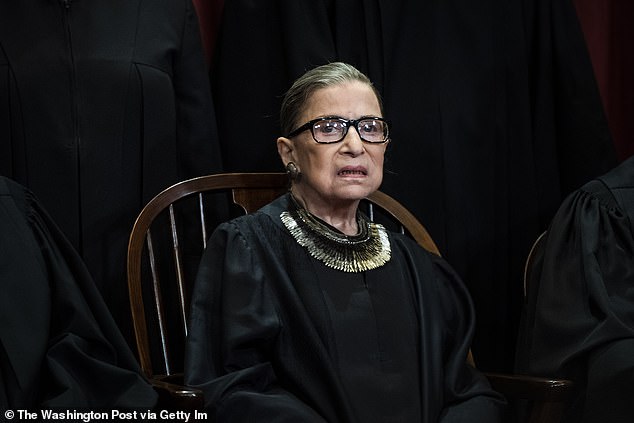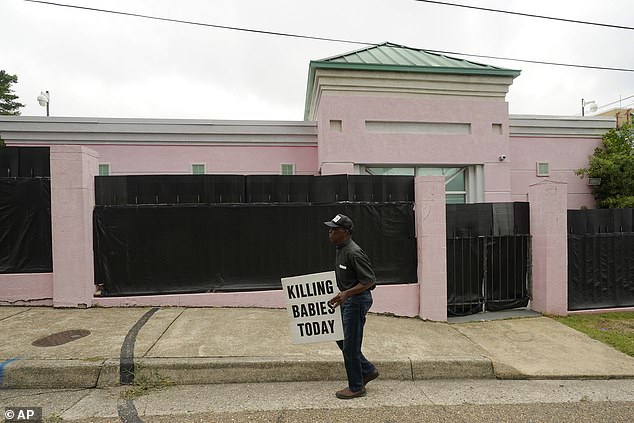How Roe v. Wade was overturned: Justice Samuel Alito’s secret plot to get other Supreme Court conservatives onboard
Judge Alito hatched a secret plot to push conservative Supreme Court justices to reject the constitutional right to abortion, a new report suggests.
The Supreme Court voted last year to overturn the landmark 1973 Roe V Wade ruling, which made abortion care legal and state abortion bans unconstitutional.
On June 24, 2022, that right was overturned when a majority in the Mississippi case Dobbs v. Jackson Women's Health Organization voted to hold that there were no constitutional protections for abortion.
Within hours of the announcement, abortion clinics in some states were forced to close.
Since the Court's ruling, 21 states have banned or restricted access to abortion.
The Supreme Court voted to overturn Roe v Wade in June 2022

Judge Alito devised a secret plot to push conservative Supreme Court justices to reject the constitutional right to abortion, a new report has found.
Justice Alito's 98-page draft option in the case was signed without revisions by Justices Neil Gorsuch, Justices Clarence Thomas, Justices Amy Coney Barrett and Justice Brett Kavanaugh.
The draft was leaked and sparked widespread protests against the country, but became law months later.
However, Judge Barrett, picked by Donald Trump to replace Ruth Bader Ginsburg to gain a conservative supermajority and pass the vote, did not even want to hear the case. The New York Times reports this.
When lawyers discussed Mississippi's request for a hearing, she initially voted yes, but later switched to no, sources told the Times.
The driving force behind the other judge's vote to hear the longshot case in May 2021 was Judge Alito, who had worked since his time as a lawyer in the Regan administration to craft a legal strategy against abortion rights, according to sources and internal documents seen by the Times.
According to the Times, Alito sensed the possibility of eradicating access to abortion in America and encouraged the other male conservatives on the bench to vote to take up the matter.
According to the report, Alito also distributed a draft preview advisory to his fellow conservatives before the rest of the bench in February 2022, in an attempt to predict the outcome in advance.
The court delayed announcing that it would hear the case so as not to appear to profit from the death of Bader Ginsburg, the leading defender of abortion rights.

Jackson Women's Health Organization Mississippi was sued by the state to prevent abortion care in a case that led to the overturn of Roe v Wade

Ruth Bader Ginsburg, the court's leading defender of abortion rights, died in 2020
After Ginsburg's death, which was likely to come under President Trump's administration, it was understood that the Republican president would seize the opportunity to install a conservative justice and end the conservative right's fifty-year campaign to end to fulfill abortion rights.
Alito was also instrumental in allowing Mississippi to conduct a “bait and switch,” turning the case from a more limited attempt to restrict abortion in the state while Ginsburg was still alive, to a full-on attack on the constitutional ruling of Roo after her death.
The court “overshot every one of its normal procedural guardrails,” wrote Richard M. Re, a law professor at the University of Virginia and a former Kavanaugh law clerk to a federal appeals court.
“The court has compromised its own deliberative process” by distancing itself from the abortion debate and intending “to return that authority to the people and their elected representatives,” he added.
Chief Justice John Roberts Jr., a conservative, worked with liberal Justice Stephen G. Breyer to prevent or at least limit the outcome.
Justice Breyer even considered saving Roe v. Wade by significantly eroding it, the Times reported.

Since the Court's ruling, 21 states have banned or restricted access to abortion

A pro-abortion protester outside the Jackson Women's Health Organization clinic in June 2022
The leaking of Justice Alito's draft to Politico helped preserve the outcome because it undermined Chief Justice Roberts and Justice Breyer's efforts to reach compromises, the paper said.
The pending votes were secret in part to give the justices a chance to change their minds, and making the draft public effectively cemented the votes.
In his brief, Judge Alito wrote that Roe and Casey were legally flawed, that the right to abortion had a limited history in the United States, and that abortion destroyed what Mississippi law called the life of an “unborn human being.”
“Roe was blatantly wrong from the start,” he wrote.
Adding, “It is time to heed the Constitution and return the issue of abortion to the elected representatives of the people.”
After the leak, Alito worked hard to maintain the five votes in favor of overturning Roe, knowing that if one vote were lost it would slow down the conservative movement against abortion.
This became abundantly clear when Justice Thomas was hospitalized with an infection for a weakling, raising fears that the conservative supermajority would not last forever.
Moreover, Chief Justice Roberts continued to try to crack the coalition and advocated compromises in a last-ditch effort to save Roe.
Liberal Justice Breyer even considered joining the chief and Kavanaugh in a compromise that would limit abortion after 15 weeks while preserving constitutional protections and limit Roe to save it, the Times reported.
Since Roe was overturned, laws restricting abortion have increasingly been seen as an albatross around the necks of Republican lawmakers.
